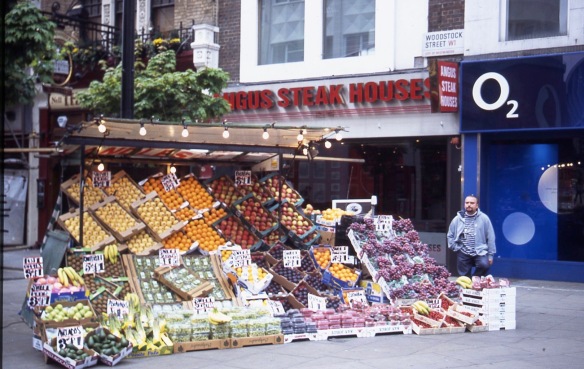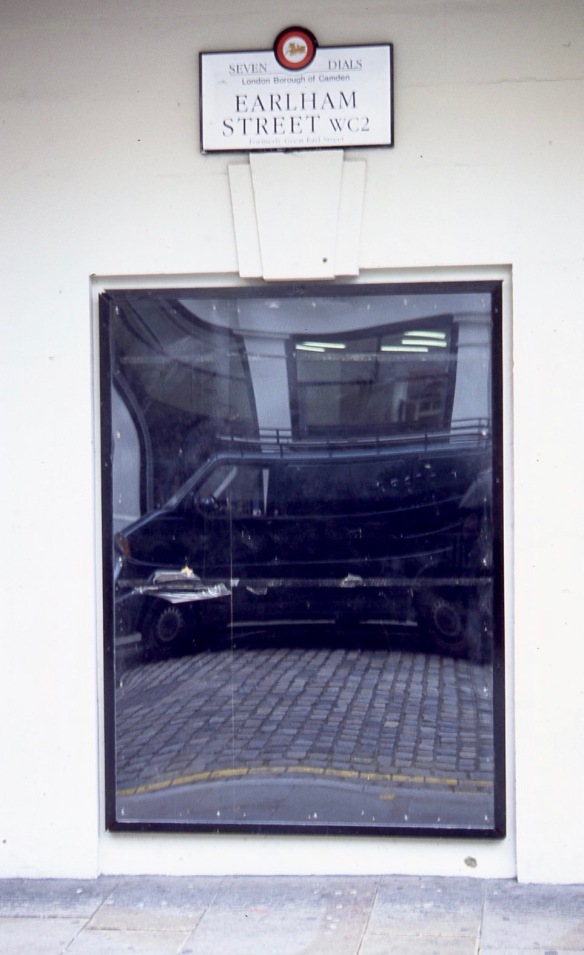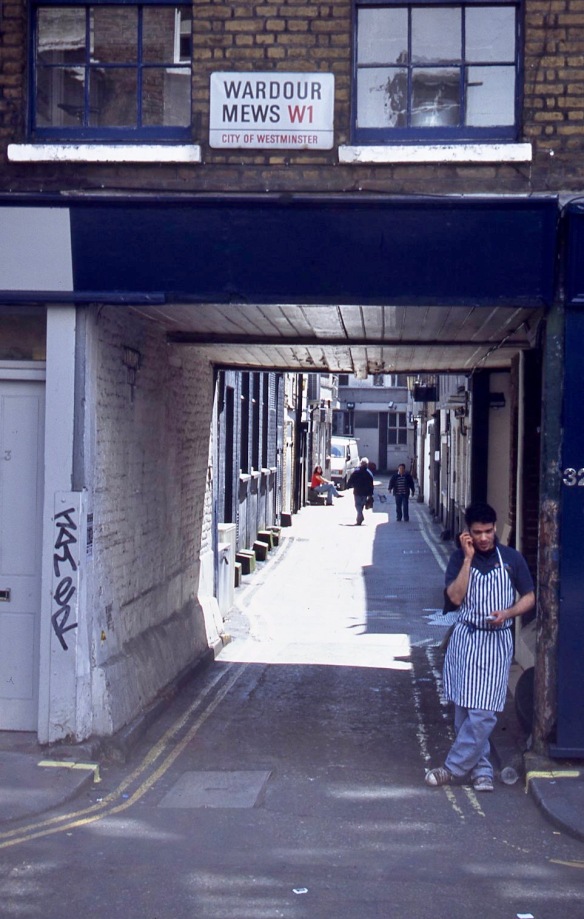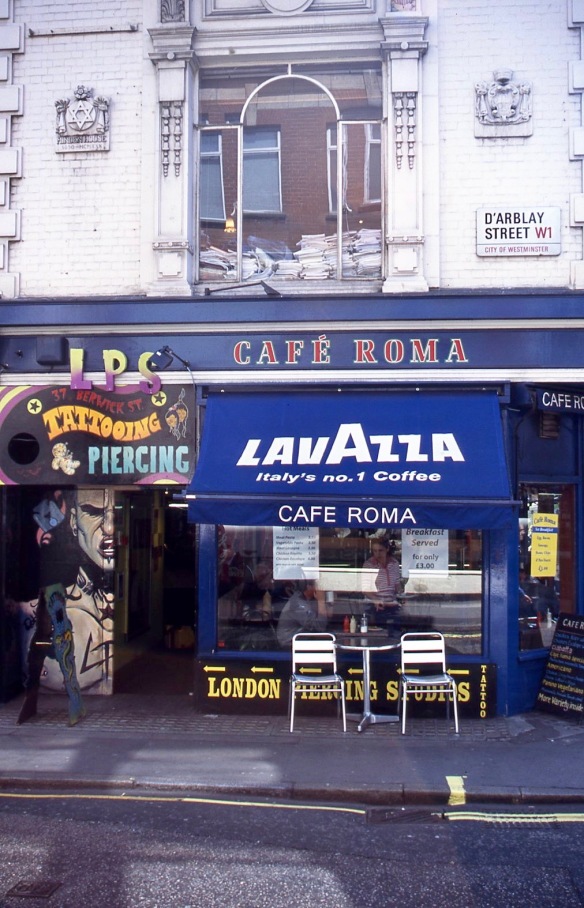CLICK ON IMAGES TO ENLARGE. REPEAT IF REQUIRED
This morning I scanned another dozen colour slides from my Streets of London series. These are from May 2005.
Sussex Place W2 leads into Hyde Park Gardens Mews where these two young girls enjoy the company of a small pony. Ross Nye and Hyde Park Stables are two nearby riding schools, so such scenes are commonplace in this street just minutes from the park.
Oxford Street W1 is a famous shopping street. Accessorize is part of the Monsoon Accessorize empire started in London in 1973 by Peter Simon, a market-stall trader. As suggested by its name this outlet specialises in accessories considered to blend well with the feminine styles that remain popular to this day.
Jessica and Ann are both wearing Monsoon garments in this photograph produced in France in September 1982. I’m not sure about Sam.
There are probably not many periods when there are no maintenance works going on along the street. Here the pavement is receiving attention. The shop on this corner is The Body Shop, like many others, no longer British.
According to Wikipedia: ‘The Body Shop International plc, trading as The Body Shop, is a British cosmetics, skin care and perfume company that was founded in 1976 by Dame Anita Roddick. It currently has a range of 1,000 products which it sells in 3,000 franchised stores internationally in 66 countries.[2] The company is based in Littlehampton, West Sussex.
The company had been owned by the French cosmetics company L’Oréal between 2006 and 2017. In June 2017, L’Oréal agreed to sell the company to the Brazilian cosmetics company Natura for £880 million, subject to Brazilian and US regulatory approval.[3]’
A less ambitious trader sells fruit at the corner with Woodstock Street.
Bill Kenwright’s revival of the musical pictured showing at the New London Theatre at the corner of Parker Street and Drury Lane ran for two and a half years from 2003-2005.
Wikipedia tells us that ‘The modern theatre’ completed in 1973, ‘is built on the site of previous taverns and music hall theatres, where a place of entertainment has been located since Elizabethan times. Nell Gwynn was associated with the tavern, which became known as the Great Mogul by the end of the 17th century, and presented entertainments in an adjoining hall, including “glee clubs” and “sing-songs”. The Mogul Saloon was built on the site in 1847, which was sometimes known as the “Turkish Saloon or the “Mogul Music Hall.” In 1851, it became the Middlesex Music Hall, known as The Old Mo. This in turn was rebuilt as the New Middlesex Theatre of Varieties, in 1911 by Frank Matcham for Oswald Stoll.[1]
In 1919, the theatre was sold to George Grossmith, Jr. and Edward Laurillard, refurbished and reopened as the Winter Garden Theatre.’
Mary Poppins ran from December 2004 to January 2008 at The Prince Edward Theatre on the corner of Old Compton Street and Garrick Street W1.
In December 1967 and January 1968, Shelton Street, just outside Old Brewer’s Yard, was one of the locations for the Doctor Who series ‘Web of Fear’.
This window in Earlham Street, Seven Dials, has the look of a fairground hall of mirrors.
It was clearly break time in Wardour Mews W1;
people chose to eat in at the Café Roma in D’Arblay Street. Gypsy Stables, the tattoo parlour at 37 Berwick Street, with its entrance on D’Arblay Street, must have been in the vanguard of our contemporary passion for permanent pellicular pigmentation.
www.eyestorm.com is an on-line art dealer selling a wide range of works. Having moved from Pollen Street, its physical gallery is now in Clerkenwell Road, EC1.
Scattered throughout London remain a number of small green huts. They are cabmen’s shelters introduced in 1875 to offer drivers of horse drawn hackney carriages an alternative to pubs in an effort to ensure they would not be drunk in charge. Captain George Armstrong, editor of The Globe newspaper, enlisted the help of the 7th Earl of Shaftesbury and several other philanthropists in order to form the Cabmen’s Shelter Fund which provided these. Today’s black cab drivers can still avail themselves of them. This one, in Warwick Avenue, W9, is in Little Venice, near my former counselling room.
“Up West” is a phrase indicating a trip to the West End of London, which is where most of today’s streets are located.
Paniza 2000 is an extremely good Spanish wine that was one of the contents of Ian’s Christmas case. It was an excellent accompaniment to Jackie’s lamb jalfrezi and onion rice with Tesco’s pakoras, onion bahjis, and vegetable samosas. The Culinary Queen was content with her customary Hoegaarden.












